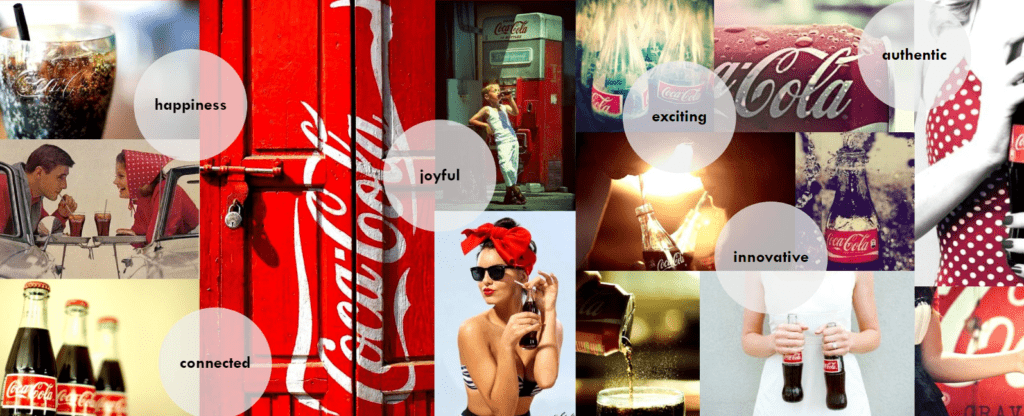What are the brand guidelines?
A brand book is a document that collects all the information about business style and main design instruments. The basic structure includes mission, values, logo, variations, color palette, fonts, the style of other visual elements (icons, banners, etc).
The use of a brand book allows brands to explain their vision to stakeholders and team members. Once all involved team members have a direct vision of their brand identity, they can communicate it to the audience efficiently.
Creating just a brand book won’t do, there are established formats, understood by design professionals, and tried-and-proven rules to follow. Experience of successful and failed brand book implementations show recurring patterns.
So, how exactly do you create a compelling brand book? What brand book mistakes do you avoid? Let’s take a look.
Branding Mistake 1: Starting with no concept
Designers are taught to think visually. The process is often intuitive and hard to explain in a rational step by step. As a creative professional, you are always influenced by other creators’ tendencies and solutions. How to define if your vision of the brand’s logos and identity derives from its needs rather than from your personal preferences?
A good design is explained well, there’s research, logic, and concept behind it. Most importantly, there’s a vision. The story behind the logo is just as important, if not more (we can use examples of successful companies and their branding strategies).
Elements of a brand concept in a brand book:
- Mission and vision: the brand defines its views in 1-2 sentences. A motto of the brand will be then repurposed in communication.
- Brand values: the guideline should describe what the company and the team believe in. Statistics have shown that customers resonate with brands that share their values.
- What brand is and isn’t: the designer should describe visual strategies and tone of voice that are not in the brand’s character – just like writers do.
- Answers to key questions. Amazon Prime answers things like – Who are we, and what’s our brand strategy? Why the change? They include guidelines as part of the strategy and explain why they needed a redesign in the first place.
Branding Mistake 2: No target audience for the brand book
Designers should take several target audiences into account when they are working on a brand guideline.
Brand target audience
The creative team should know who is the ideal customer (or several of them), what tone of conversation they prefer, and find natural. Slack, for instance, started building its product with a reference to software developers. Their brand book clearly displays the values of an innovative progressive user, the one who values transparency and creativity over overused stamps.
Guideline target audience
A slim percentage of end customers will ever download the brand book itself, although they will definitely experience indirect consequences. However, it’s important to understand who are the primary readers of the document, solve their needs, and resolve concerns.
Who works with a brand book?
- Partners: companies who will display your logo, identity, feature your brand in their ads and offers;
- Resellers: companies who will act in your name to provide a better service should use the style that’s consistent with your brand book.
- Designers: people who create visual content for the brand need to have documentation that will guide them for years to come;
- Marketers: campaigns and promotional messages should be coherent with values and style in the brand book. For instance, if a Slack campaign would suddenly call their users “ninjas”, that would be a direct contradiction with the brand’s style.
- Press: journalists that feature information about the company also need guidance on how and when a company’s visual can be used.
- Stakeholders: investors, partners, and involved vendors need to understand the specifics of the brand’s communication, design, and marketing approach. It can help attract funding and partners – if the values of a stakeholder end up corresponding to the brand’s vision.
Branding Mistake 3: Logo with no context
The increasing usage of automated logo makers makes logo designers reasonably worried about their expertise. Even if the professional can tell the difference between a custom-designed font and graphics, clients might not. Before, if designers competed with other experts in the field, now they need to take automated solutions into account.
The problem here is that designers struggle with presenting their work in a marketable way. Often, they send the logo in the email.
Automated solutions are already ahead because they also present logo on the page, merch, notebooks, cups – anywhere. Even though designers put a lot more thought into their results, the final result doesn’t reflect it.
The solution is creating a brand book, even if your client didn’t ask for a brand book per se. Presenting logos with their usage guidelines, variations, and history is standard practice for high-paid professional designers.
☝🏻 Tip: Now, you don’t need to spend a lot of time designing a brand book, like in the good old days. Automatic solutions are there to help you create brand guidelines online with less time spent on technicalities. Like Gingersauce.
Gingersauce is a professional tool for creating brand books. The first step is to upload your logo. The smart automation built into the app entails offering you a range of automatically created logo variations, which you can either choose or decline. Either way, the application takes your assets and creates an awesome brand book around them. Every step is customizable to your taste. Quick and easy.
Branding Mistake 4: Relying only on creativity
We spend our entire professional lives trying to be creative and think visually. We love looking at inspiration boards, creating mood boards, and finally finding the perfect combination.
However, the clients of designers (business owners) aren’t wired in the same way. When they see a logo, they want to understand how to use it in various contexts, what it reflects their advantages, and why it’s better than what their competitors offer.
Branding Mistake 5: Assets are not organized
Brand identity isn’t composed merely by logo and fonts. It’s an aspect that’s easy to miss for designers that don’t have much branding experience. They are focused on their side of the task and don’t consider ways in which they could help the entire team.
Your logos, fonts, and guidelines won’t just be used by designers. More often than not, they will be applied by people who have only a basic understanding of Photoshop and composition, if any. If there’s no organization of all these elements, your work won’t be used at its full potential.
Branding Mistake 6: Not enough logo variations
Even if you created a well-described and explained logo, it’s not enough on its own. You need to present clients with options. Design is highly subjective, and the first version will hardly be the ultimate one.
The different options will be utilized for the different applications and usage of the logo. There are endless places and formats on which the logo will need to be. Our job is to think as wide as possible and to give our solution for all anticipated formats.
Similarly, our visuals should be prepared for different contexts – be it in social media, website, printed materials, wide format printing for large-scale graphics or signage, etc.
Overall, providing multiple options shows dedication to the brand and elevates the designer’s reputation. Not including the logo variations into your brand guidelines is one of the most common brand book mistakes among newbie designers.
☝🏻 Tip: Creating variations can be very time-consuming. Our tip is to try creating them automatically using Gingersauce. All you need to do is upload a logo, and the system will create different color variations, the favicon, and the negative space options. If you need any other ones, you can upload them manually, and later present everything in a brand book.
Branding Mistake 7: Inconsistency
The goal of a professional designer is to create visuals that follow a specific theme but are still flexible. When you create logo variations, you adapt them to different mediums and occasions. When you are doing that, a priority should also be on keeping the same style across all elements.
By sticking to a unified style throughout all the materials, designers show respect to their brand and end customers.
It’s a sign of professionalism: you demonstrate your ability to create a long-lasting impression with the same tools.
Branding Mistake 8: Not enough use cases
Obviously, designers alone can account for all the circumstances under which their work will be used. It depends on the promotional mix, chosen by the brand, its communication strategy, and resources. Still, it’s not an excuse to fully refrain from providing the content.
Logo, brand books, fonts, branding visuals aren’t static products. They are dynamically-evolving projects that need context. Among all the brand book mistakes, this one may impact your presentation the most.
If you showcase your work in different realistic situations, your clients will perceive your work as something that already works for their brand.
- Fit logos, fonts, icons, and other branding elements on different mediums: pages of different formats, screenshots, merchandise, interface.
- Think about formal and informal communication. Social media is a friendlier medium where you can allow room for more variation. It’s drastically different from official letters, commercial offers, and documentation. Documents of both styles feature visual elements, but they must fit the occasion.
- Show real examples. The presentation of the branding material should be similar to the real-life context.
Branding Mistake 9: Wrong proportions
When your branding materials will be actually used, clients’ team members will have to go beyond images, proposed in the assets. They need to know how to resize the image without distorting the original look. This is where proportions and exact geometry come in.
Proportions are objective parameters behind the look and feel of the visual. It’s a way to predict how an image will be perceived.
You might be interested in: Using the Golden Ratio Logo Design: Why & How.
Most designers are familiar with the laws of composition and rules of good proportion. The image shouldn’t be monotonous or imbalanced. Something too orderly is perceived as boring, whereas a chaotic visual is hard to process.
Using smart solutions allows you to rely on algorithms to define the optimal combination of elements and space between them. You can tweak the end layout from your perspective, but it will be based on precise calculations – not just on subjective aesthetics.
☝🏻 Tip: In our Gingersauce proportions calculator, you can try on different styles of dividing your logo: Leonardo, Michelangelo, Fibonacci, and Vitruvius. Each one is calculated differently. The Fibonacci has an added characteristic. When uploading a logo with specific proportions of 1:1.618 (golden rule), 2:3, 3:5, 1:3, 1:5, or 5:8 you will get an added description. The calculation will serve as a guide on the family designs, and show the client that you had certain proportions in mind while designing the visual.

Mistake 10: Not including additional graphic assets
One of the biggest branding mistakes is stopping upon the creation of the brand identity. Technically, you can, but there’s another efficient and simple way of improving the look and feel of your visuals.
It’s a simple lifehack: always include “supporting” visuals into your logobook, brand guidelines, or visual presentation.
Supporting visuals are the ones that:
- Reflect the brand’s personality and tone of voice: use particular colors, symbols, elements
- Showcase brand’s values in a creative way;
- Demonstrate the key themes from brands’ mood board;
- Can be used directly in communication and promotional materials
- Are easy to understand even for people with no design background.

Branding Mistake 11: No design automation
One thing to remember for designers who want to stay at the top level long-term is: be mindful of burning out. We need to be highly creative – this is the main requirement of this field. If you keep spending your energy on repetitive manual tasks, you are setting yourself up for creative stagnation.
The more complex are the tasks, the easier it is to get lost in mundane processes. This is why so many designers who got to the top level start losing passion for their work.
Automation is an easy and accessible way of solving it. You don’t have to use amateur tools that don’t suit your needs. There are plenty of professional instruments – like Gingersauce, an expert tool for creating brand books, built by designers and for designers.
Want to know more details on how to create a brand book?
Download our e-book where we dive even deeper into the mistakes, with use-cases analysis and more our tips & tricks.
Download a brand book creation e-book
Create brand books with Gingersauce!
Automation is a helper, not a job-stealer. Make the most out of the digitalization era with Gingersauce. Create brand books in just a few clicks to present your visuals like the professional that you are.
Gingersauce is a professional tool, meaning it was created based on the industry standards recognized by the top players. Upload your logo, and see the platform work its magic.



